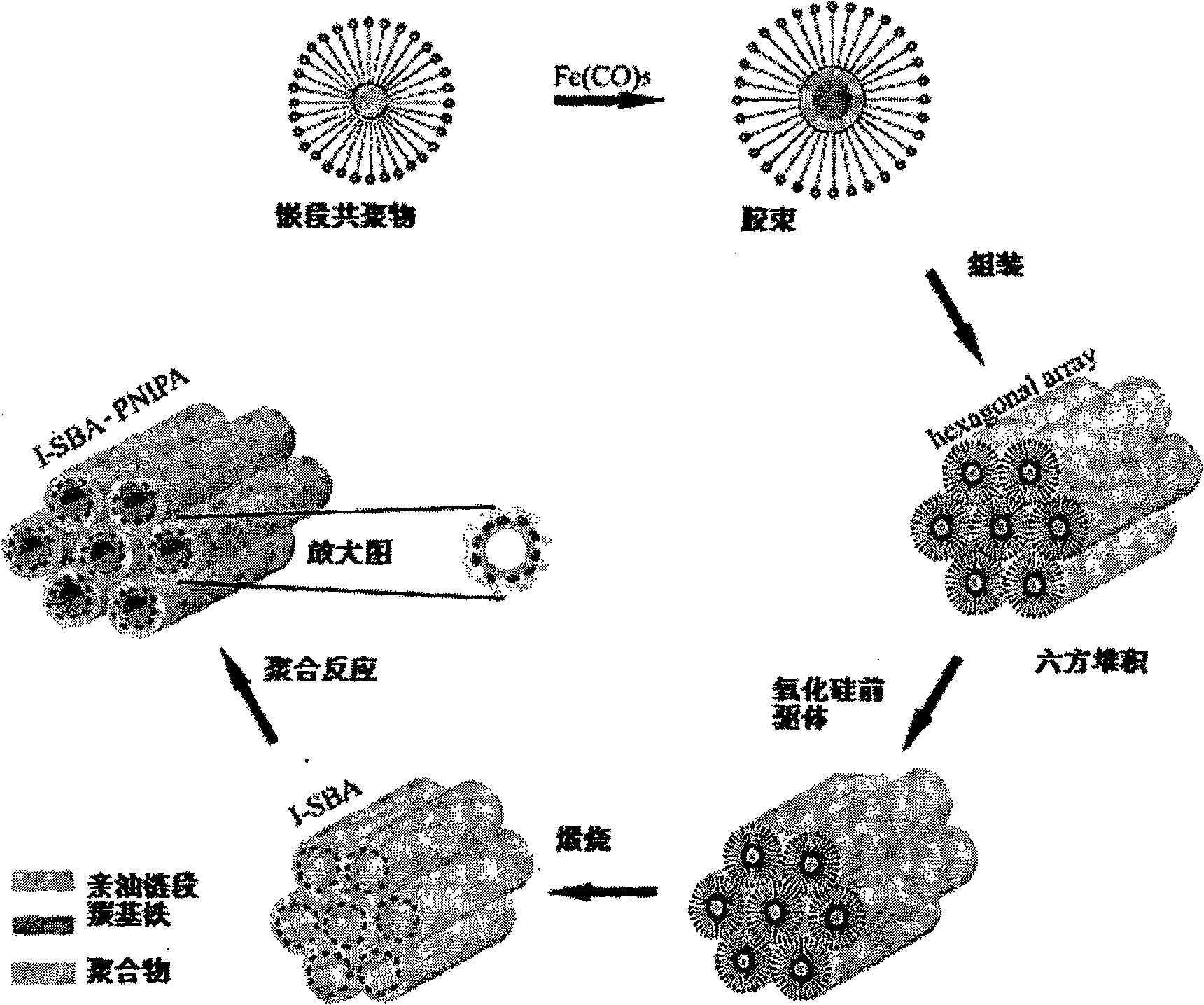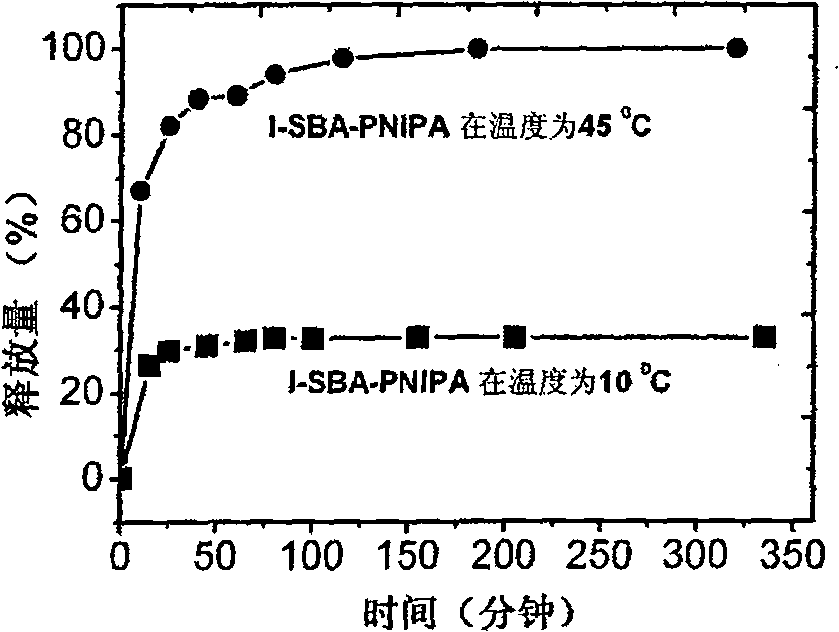Process for preparing original position of nanometer laminated composite material
A nanocomposite material and in-situ preparation technology, applied in the field of in-situ preparation of nanocomposite materials, can solve the problems of unsuitable adsorption and loading, limited content, etc., and achieve the effect of obvious temperature response performance
- Summary
- Abstract
- Description
- Claims
- Application Information
AI Technical Summary
Problems solved by technology
Method used
Image
Examples
Embodiment 1
[0024] see figure 1 The process flow shown. 1 part of copolymer P123 (EO 20 PO 70 EO 20 ) was added to 120mL of 2M hydrochloric acid solution, and stirred at 40°C for 2h until it was completely dissolved. Then, slowly add 1 part of carbonyl iron Fe(CO) 5 (chemically pure), and stirred for 1h. Then, under the condition of constant stirring, 4 parts of tetraethyl orthosilicate (TEOS) was added, and after stirring at 45° C. for 24 hours, it was moved to an oven at 80° C. for 24 hours. After filtration, the obtained precipitate was dried at room temperature, then transferred to a muffle furnace at 500°C for calcination for 6 hours, and then the obtained brown powder was heat-treated in a vacuum furnace at 450°C for 4 hours, and finally the magnetic medium was obtained. Porous silica I-SBA composites.
[0025] Completely dissolve 1 / 10 part (eg 0.2g) of isopropylacrylamide (NIPA), a certain amount of azobisisobutyronitrile (AIBN) and N,N'-methylenebisacrylamide in 2mL of alco...
Embodiment 2
[0027] 5 parts of copolymer P123 (EO 20 PO 70 EO 20 ) into 2M hydrochloric acid solution, and stirred at 50°C for 2h until it was completely dissolved. Then, slowly add 5 parts of carbonyl iron Fe(CO) 5(chemically pure), and stirred for 1h. Then, under the condition of constant stirring, 8 parts of tetraethyl orthosilicate (TEOS) was added, and after stirring at 50° C. for 24 hours, it was moved to an oven at 90° C. for 24 hours. After filtration, the obtained precipitate was dried at room temperature, then transferred to a muffle furnace at 550°C for calcination for 6 hours, and then the obtained brown powder was heat-treated in a vacuum furnace at 480°C for 4 hours, and finally the magnetic medium was obtained. Porous silica I-SBA composites.
[0028] Dissolve 2 parts of isopropylacrylamide (NIPA), azobisisobutyronitrile (AIBN) and a small amount of N,N'-methylenebisacrylamide in 40mL of alcohol, slowly add 10g of the above-prepared In the magnetic silica material I-SB...
Embodiment 3
[0030] 4 parts of copolymer P123 (EO 20 PO 70 EO 20 ) was added to 2M hydrochloric acid solution, and stirred at 30°C for 2h until it was completely dissolved. Then, slowly add 4 parts of carbonyl iron Fe(CO) 5 (chemically pure), and stirred for 1h. Then, under the condition of constant stirring, 6 parts of tetraethyl orthosilicate (TEOS) was added, and after stirring at 30° C. for 24 hours, it was moved to an oven at 70° C. for 24 hours. After filtration, the obtained precipitate was dried at room temperature, then transferred to a muffle furnace at 450°C for calcination for 6 hours, and then the obtained brown powder was heat-treated in a vacuum furnace at 420°C for 4 hours, and finally the magnetic medium was obtained. Porous silica I-SBA composites.
[0031] Completely dissolve 1 part of isopropylacrylamide (NIPA), a certain amount of azobisisobutyronitrile (AIBN) and a small amount of N, N'-methylenebisacrylamide in 20mL of alcohol, slowly add 5g of the above In the...
PUM
| Property | Measurement | Unit |
|---|---|---|
| pore size | aaaaa | aaaaa |
| diameter | aaaaa | aaaaa |
| specific surface area | aaaaa | aaaaa |
Abstract
Description
Claims
Application Information
 Login to View More
Login to View More - R&D
- Intellectual Property
- Life Sciences
- Materials
- Tech Scout
- Unparalleled Data Quality
- Higher Quality Content
- 60% Fewer Hallucinations
Browse by: Latest US Patents, China's latest patents, Technical Efficacy Thesaurus, Application Domain, Technology Topic, Popular Technical Reports.
© 2025 PatSnap. All rights reserved.Legal|Privacy policy|Modern Slavery Act Transparency Statement|Sitemap|About US| Contact US: help@patsnap.com



